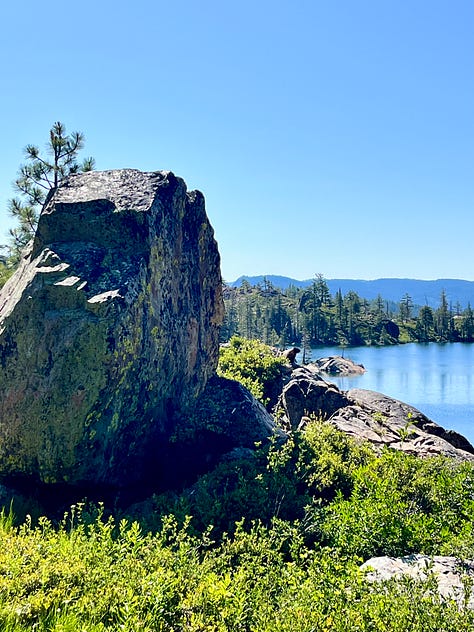Is 30 Years Enough?
We wanted flying cars; instead we got 140 characters — Peter Thiel
Peter’s an OG member of Silicon Valley’s glitterati and a kingmaker. Convinced society is broken, he backed JD Vance as senator and then Trump, all in the name of progress via disruption. This is the underlying philosophy behind tech’s move to the right that I covered in Tech bends the knee.
Their uber message is we’re stuck. We are not progressing as humanity should, and big changes are needed to unstick us lest we roll back into the dark ages. For me, living a life where I’ve seen the computers progress from punch cards to the Internet and now AI, it’s hard to see his position.
But then I had a little run-in that made me rethink it—more on that later—and so I did a little research.
When I started writing, newly freed from my tech blinders, I enthusiastically dove into the latest in fields I’d been fascinated with before, but didn’t have the time to keep up with. Stuff like space travel, energy and robotics.
My enthusiasm waned. Two years ago, I watched each new Starship launch with anticipation; now they keep blowing up. I hoped we’d figure out novel energy sources to address global warming like the ever-present promise of fusion; it remains elusive. I was excited about EVs and the idea of a wholesale transition of automobiles from fossil fuels—progress here continues to be halting.
Space exploration peaked in 1969 when we landed on the moon. Automobiles and manufacturing had the last revolutionary breakthrough with the assembly line and Henry Ford in 1913. The last scale clean energy revolution was nuclear back in 1954.
A bit of prompting gave me a report card across key fields. Most of these revolutionary or step changes go back 60 years before I was born. It’s not to say that we haven’t progressed since, we are ever iterating and improving, but these are evolutionary improvements.
¡Viva la revolución!
On the road a few weeks back, we met Angela and her 30 year old camper van. She flagged us down enthusiastically and before I could lace up my boots, JFran had disappeared inside her van. I spitballed briefly with her husband—like her, he was geared up head-to-toe like they were about to traverse the Sahara—until she came back out, and ushered me in after confirming I wasn’t over 6’ tall.
Angela’s van is the same make as ours, but 30 years older. She showed us all the features and customizations and how she dismissed buying one until she fell in love with this teal beauty.
We showed her ours. Angela named her van Abby Normal after the bad brain Igor picks out by mistake in Young Frankenstein. I gave her an Amazing Spider Van sticker; hello Angela if you’re reading this.
Here’s the 1994 brochure for Abby Normal:
I’d kill for that purple velour interior versus our gray one. Back in 1994, I pimped my (first) ride—this bitchin’ Mazda B2000 5-speed stick—with a resplendent shag blue carpet kit.1
What struck me is that 30 years later it’s the same van.
Sure the ASV has better specs than Abby—wrap-around windows, high ceiling, diesel with great gas mileage, batteries and solar to run off-grid for days, comfiest bed ever, etc. There are 30 years worth of incremental improvements, and it’s a wonderful design—but at its core, it’s all the same stuff.
Where are the revolutionary improvements, where’s the paradigm SHIFT? Why can’t the ASV fly by now?
If you came for the pics, here are some of the hike (find the marmot):



Back to Peter. 140 characters is a reference to Twitter’s original message length. Social media was an unintended consequence of tech that’s all kinds of terrible and hasn’t moved us forward as a society—no argument from me here.
Social media has done plenty to divide us—surely we can keep progress rolling without tearing the fabric of our society further apart. Yes there’s bureaucracy and regulations and institutional inertia, but none of this is new.
Consider an optimistic version of this narrative.
My dad had open-heart surgery to replace his aortic valve in the ‘90s. Cracked his ribs, big scar down his chest; rock star surgeon worked on him all day. Thirty years later, this doctor replaced that same valve arthroscopically (non-invasive) when my dad was 93.
I thought it would kill him, here he is on his way out of the hospital the next day:
There’s a lot more magic where that came from—while DNA’s double helix was discovered in the 1950s, CRISPR, a technique to edit it, was invented just 10 years ago, and new treatments are available now. In energy, solar now makes up about 15% of the world’s energy requirements, up from a rounding error 10 years ago. Last week, the Chaos Monkey genned up a CAD design and 3D printed a prototype in a day— something that used to take weeks.
Can’t forget AI. There’s a chance AI can help researchers cure cancer, figure out fusion, launch the big rockets without the big explosions. Computing has always been a way to help people figure stuff out rather than a means unto itself. That’s the nut of the problem with Silicon Valley trying to apply disruptive techniques that worked for tech but aren’t directly transferrable to physics, for example.
So here’s to the quiet revolutions—heart valves swapped through keyholes, a society powered by the sun, and vans that might yet sprout wings. Let the next generation clock in; Peter can watch from the bleachers.
That B2000 got me through regular cross-coast drives from LA to Seattle while I was in grad school. My first winter in Seattle, the heater gave out, and after a month of driving around in jacket, gloves and hat, my dad loaned me the money to get it fixed. When we had the big snowstorm in 1993, the lock froze so I hitched a ride to the airport from a friend with a garage.








I have concerns with AI and what people will believe is real in social media. Nice place to hike! I may have only put my feet in the water. Those high mountain lakes get cold! Aaah, that rocking blue shag carpet in the back of your truck.... And Thiel is a dick!
Andrew I loved this post. My concern is ethical uses of AI and it's impact on the environment. Any thoughts on that perhaps a future post .✌️🌞